Birds, Bees, and Human Visual Perception
There’s a saying that “perception is reality”—meaning how we see things is how we believe them to be. However, others may have different perceptions that show a different reality. The way humans see the world is not the same as how many other species on the planet see things. For example, a bee’s eyes are tuned to a different range of wavelengths on the electromagnetic spectrum including ultraviolet light, which enables them to discern color patterns in flowers that are invisible to people.1
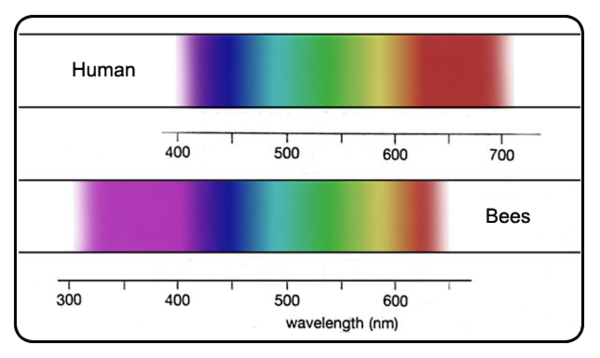
Color spectrum visible to the human eye (top) from wavelengths of roughly 380 nanometer (nm)-740 nm compared to bee vision that extends to 300 nm in the ultraviolet portion of the spectrum (bottom). (Image Source: West Mt. Apiary)
Bees (and all other insects) have compound eyes—unlike humans’ single-lensed eyeballs. Bees also have three small eyes, called oceli, that perceive the ultraviolet spectrum. Unbeknownst to humans, many flowers have markings visible in the ultraviolet range that function as a target, directing bees to the center of the flower where the nectar (i.e., bee food) lies. In exchange for lunch, a bee’s body picks up pollen from the flower and then carries it to other flowers, thus pollinating plants and crops.
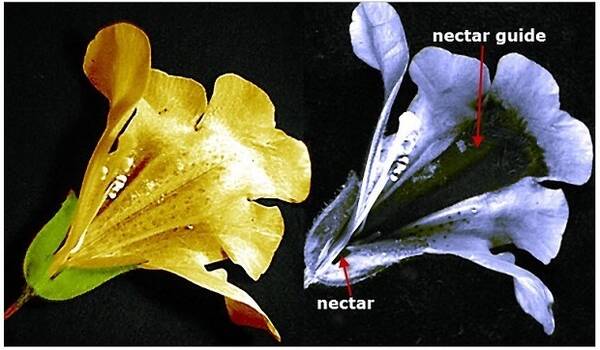
Images of a Mimulus flower in visible light as seen by humans (left), and with ultraviolet light as seen by bees, butterflies, and other insects (right), showing a dark strip called a “nectar guide” directing pollinators to their target. (Image Source)
Compound eyes are typically made up of thousands (or in some insects, millions) of tiny facets called “ommatidia,” each of which has a tiny lens that focuses light and special pigments for detecting color. Each hexagon-shaped facet is connected to a cone with eight photoreceptor cells. “In each cone, there are two receptors for each of the colors blue, yellowy-green, and ultraviolet. Information from all the facets is collated by the bee's brain and makes a mosaic picture of its surroundings. It sounds complicated but it's amazingly fast. Bees perceive color three to five times faster than humans. This means they can see individual flowers blowing in the wind even while flying.”2 Learn more about compound eyes and insect vision.
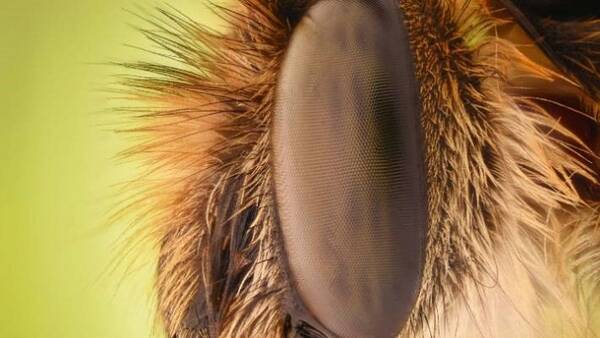
Thousands of facets in a bee’s compound eye.
Human Visual Perception
The human eye is a remarkable instrument, capable of a high degree of visual acuity, detailed resolution, and accurate depth perception at near and far distances. We also have a high sensitivity to color across a portion of the electromagnetic light spectrum from roughly 380 to 740 nm, which we naturally call the “visible” spectrum since it’s what’s visible to us (perception is reality…?).
Human eyes are categorized as a “camera-type” eye because, like a camera lens that focuses incoming light onto a receptive layer of film, the human cornea focuses light entering the eye onto the retina, a light-sensitive membrane. The cornea bends (refracts) the rays that pass through the round entrance of the pupil. The iris (the colored portion of the eye that surrounds the pupil) opens and closes, making the pupil bigger or smaller. This regulates the amount of light passing through. Light passes through the cornea and then through a thin lens, which also changes shape so it can further bend the rays and focus them on the retina.
The retina, which sits at the back of the eye, is a thin layer of tissue that contains millions of tiny light-sensing nerve cells. These nerve cells are called rods and cones because of their distinct shapes. Cones are concentrated in the center of the retina, in an area called the macula. The macula is responsible for our central focus region of detailed vision, allowing you to see fine detail and color and recognize faces.
In a brightly lit environment, cones provide clear, sharp central vision to detect color and detail. They contain color pigments, or photo-detecting molecules, and come in three types that are each sensitive to a different range of wavelengths of light corresponding to red, blue, and green.
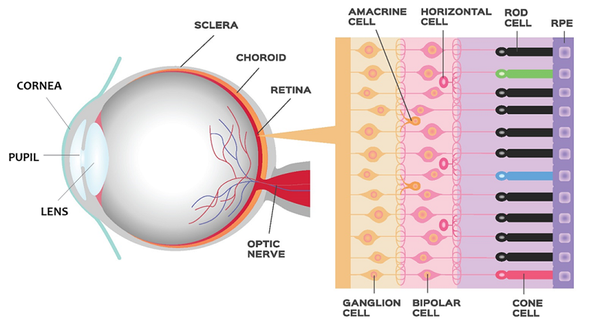
A diagram of the structures of the human eye including the pupil (where light enters the eye), and the cornea and lens, which both help focus the light onto the retina, where rods and cones are found. (Image adapted from the American Optometric Association)
Rods are located outside the macula and extend all the way to the outer edge of the retina. They provide peripheral (side) vision, and allow us to see with monochromatic vision in dim light and at night. Rods and cones convert the light they receive into electrical impulses, which are sent through the optic nerve to the brain, and the brain interprets the signals sent from both eyes to produce an image that we “see.”
The concentration of cones in the macula is what makes human vision particularly acute. Reportedly, the resolution of the human eye equates to 576 megapixels.3 Our color perception is also very refined—an average human can distinguish between roughly 1 million different colors, although some can discern 7 million or more. Landmark research at the University of Rochester determined that the number of color sensitive cones in a person’s retina can vary by as much as a 40 times, but the number of cones doesn’t correlate with different perception of color (e.g., red vs. orange).4 This indicates that our color vision is less a result of eye structure and more a function of how our brains interpret the information it receives (perception is…perception?).
About The Birds
Birds typically have much higher visual acuity than humans—needed for safety in flight and for spotting prey. It may not be surprising to learn that raptors (eagles and hawks) have some of the most acute eyesight on the planet (thus the saying “eyes like a hawk”). Their eyes are densely packed with cones for fine-grained (high resolution) images—in fact eagles see with about 2.5 times the resolution of humans.5 They have very few rods, however, so they are daytime rather than nighttime hunters. Nocturnal hunting birds like owls instead have a higher concentration of rods, enabling them to see well in the dark.
Like most birds, a hawk’s eyes are rotated towards the front of its head, meaning they have some degree of binocular vision. Binocular vision provides the advantage of accurate depth perception—good for tracking fast-moving prey on the ground. Owls have the most binocular vision of all, with forward-facing eyes and an almost entirely overlapping field of view like humans. Woodcocks, on the other hand, have their eyes rotated upwards towards the back of their heads, which gives them binocular vision behind themselves—useful for spotting predators overhead when digging in the mud for food.

Harris Hawk (left), barred owl (center) and the rear-view of a woodcock (right).
Other Critters
Anyone who’s had a dog or cat has probably wondered how their furry friends perceive the world. A common myth is that dogs are color blind. In reality, they do see some colors, including parts of the ultraviolet spectrum that humans don’t see, but they can’t distinguish green and red hues. Their distance vision is also a bit blurry—they rely much more on their nose than humans do to help interpret their surrounding environment.
Unlike dogs, cats can see green hues, but they also don’t perceive reds. They have a larger number of rods in their eyes, which (as any cat owner can tell you) enhances their ability to make mischief during the night.

The visible spectrum for dogs (left), and a comparison of what colors a human sees vs. a cat (right). (Images sources: left and right)
Here are some additional fun facts about vision in the animal kingdom:
- Eyes on horses and zebras point sideways, which gives them excellent peripheral vision (for spotting predators in the landscape like lions or wolves), but a blind spot right in front of their noses.6
- Snakes have thermal vision, with infrared-sensors located in deep grooves on their snouts, enabling them to see warm-blooded prey.6
- Owls are the only bird who can perceive the color blue.6
- Some animals don’t rely on vision at all. For example, the star mole is blind, but uses its extremely sensitive touch organ to detect, catch, and eat food faster than the human eye can follow, in about 300 milliseconds.7
To see a demonstration of how dogs, geckos, snails, giant clams, and even jumping spiders view the world, the Natural History Museum in London provides some slider photos that you can play with to compare human vision with that of various creatures.
There is even a free open source software app you can download on your phone that lets you view your photos as they might appear to different animals. Called the Quantitative Colour Pattern Analysis (QCPA)8 framework, it was developed by scientists in Australia, as described in a recent paper published by the British Ecological Society.9
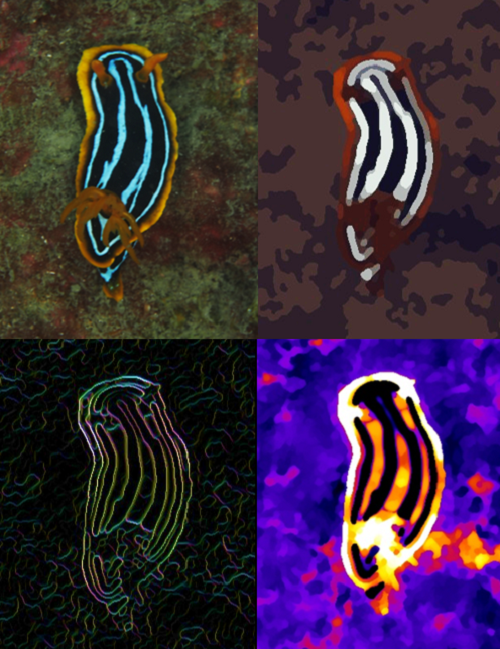
Four images of a nudibranch (sea slug) using the QCPA app. Top left: the image taken with a digital camera, top right: image as perceived by a triggerfish in 5 m depth at 10 cm viewing distance. Bottom left: color contrast of edges as perceived by a triggerfish. Bottom right: a heatmap of the perception of color saturation by the triggerfish. (Image Credit: Cedric van den Berg et al.8)
Photometry: Matching Human Visual Perception
Here at Radiant, we’ve spent more than 25 years developing systems for accurate measurement of light and color as perceived by the human eye. The basis of all of Radiant’s technology, photometry and colorimetry are the sciences of measuring light in relation to how its brightness (luminance) and color (chromaticity) is seen by humans.
Light measurement systems such as Radiant’s ProMetric® Imaging Photometers and Colorimeters are designed to measure brightness and color to the standard of human vision. Using CIE-matched (tristimulus) optical filters and scientific-grade imaging sensors, our high-resolution camera systems capture meaningful data that helps guide human-centric design and accurate evaluation of many of today's lighting and display products.
To learn more about measuring light and color correlated to human visual perception, view our recent webinar: Principles of Light & Color Measurement. In it, we discuss the foundations of photometry and colorimetry and introduce photometric technologies that leverage these principles to accurately quantify the human visual response for the purpose of ensuring quality in light and display products. Topics covered include:
- How the human eye responds to light and color
- Quantifying color based on CIE tristimulus curves
- Technology designed to replicate human visual response
- Optical metrology systems and benefits of imaging for light measurement

CITATIONS
- "2019: What Just Happened?", New York Times Special Section, December 29, 2019, page 6
- Smith, Barbara, “How Bees Use Their Unique Vision to Search For Food and Find Their Way Home”, Stuff, August 28, 2017
- Hamer, A., “How Many Megapixels Is the Human Eye?”, Curiosity, December 19, 2016.
- “Color Perception is Not In the Eye of the Beholder—It’s In the Brain, Science Daily, October 26, 2005
- Preston, E., “How Animals See the World”, Nautilus, March 20, 2014
- “32 Facts About Animal Eyes”, Discovery Eye, August 5, 2014 (retrieved April 13, 2020)
- “Star-nosed Mole”, Wikipedia https://en.wikipedia.org/wiki/Star-nosed_mole (retrieved April 9, 2020)
- Ferreira, B., “Scientists Created Open Source Tools to See in Animal Vision”, Motherboard, December 3, 2019
- Van den Berg, C., et al., “Quantitative Colour Pattern Analysis (QCPA): A comprehensive framework for the analysis of colour patterns in nature”, Methods in Ecology and Evolution, December 2, 2019, https://doi.org/10.1111/2041-210X.13328
Join Mailing List
Stay up to date on our latest products, blog content, and events.
Join our Mailing List
